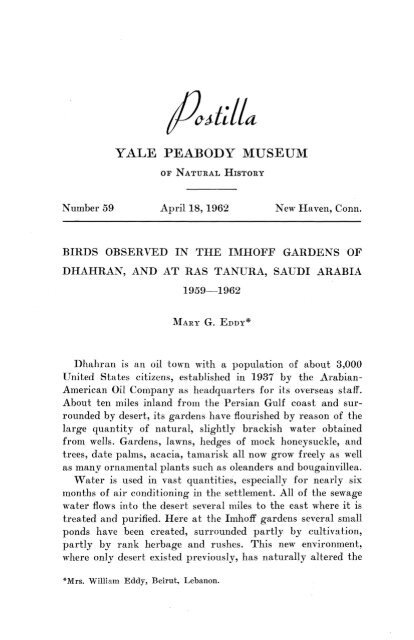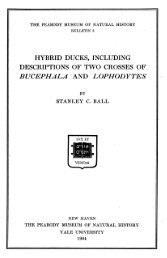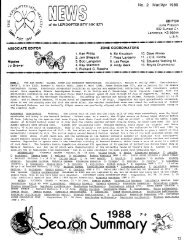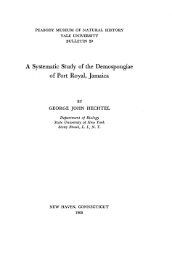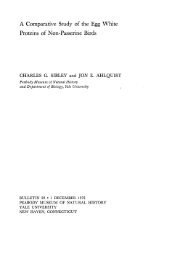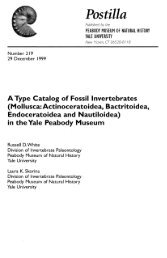Yale Peabody Museum Postilla - Peabody Museum of Natural History
Yale Peabody Museum Postilla - Peabody Museum of Natural History
Yale Peabody Museum Postilla - Peabody Museum of Natural History
Create successful ePaper yourself
Turn your PDF publications into a flip-book with our unique Google optimized e-Paper software.
YALE PEABODY MUSEUM<br />
OF NATURAL HISTORY<br />
Number 59 April 18, 1962 New Haven, Conn.<br />
BIRDS OBSERVED IN THE IMHOFF GARDENS OF<br />
DHAHRAN, AND AT RAS TANURA, SAUDI ARABIA<br />
1959—1962<br />
MARY G. EDDY*<br />
Dhahran is an oil town with a population <strong>of</strong> about 3,000<br />
United States citizens, established in 1937 by the Arabian-<br />
American Oil Company as headquarters for its overseas staff.<br />
About ten miles inland from the Persian Gulf coast and surrounded<br />
by desert, its gardens have flourished by reason <strong>of</strong> the<br />
large quantity <strong>of</strong> natural, slightly brackish water obtained<br />
from wells. Gardens, lawns, hedges <strong>of</strong> mock honeysuckle, and<br />
trees, date palms, acacia, tamarisk all now grow freely as well<br />
as many ornamental plants such as oleanders and bougainvillea.<br />
Water is used in vast quantities, especially for nearly six<br />
months <strong>of</strong> air conditioning in the settlement. All <strong>of</strong> the sewage<br />
water flows into the desert several miles to the east where it is<br />
treated and purified. Here at the Imh<strong>of</strong>f gardens several small<br />
ponds have been created, surrounded partly by cultivation,<br />
partly by rank herbage and rushes. This new environment,<br />
where only desert existed previously, has naturally altered the<br />
*Mrs. William Eddy, Beirut, Lebanon.
2 <strong>Postilla</strong> <strong>Yale</strong> <strong>Peabody</strong> <strong>Museum</strong> No. 59<br />
bird population radically. It was first mentioned by Ripley<br />
(1951) in his paper on a visit to Dhahran and Bahrein in the<br />
summer <strong>of</strong> 1950. It was <strong>of</strong> course totally unknown to Ticehurst<br />
and Cheesman (1925) in the only other published short paper<br />
on the area.<br />
In winter the Imh<strong>of</strong>f gardens with their lakes become a<br />
stopping place for many migrants. In summer, the tamarisk<br />
trees and garden atmosphere provide a welcome shelter from<br />
the burning heat <strong>of</strong> the open desert, though temperatures may<br />
reach 120 degrees Fahrenheit in the shade. The gardens are<br />
now surrounded by a fence which gives added protection to the<br />
bird fauna, although poachers attempt to shoot at the duck<br />
during the winter migration.<br />
My first visit to these gardens occurred in July, 1950<br />
accompanied by Mr. and Mrs. S. Dillon Ripley. Since then I<br />
have always visited the Imh<strong>of</strong>f gardens as well as the sand<br />
spits along the coast near Ras Tanura, the oil refinery forty<br />
miles north along the coast, whenever my husband and I visited<br />
eastern Saudi Arabia during the ensuing years. For texts I<br />
have used Peterson, Mountfort and Hollom's Field Guide to<br />
the Birds <strong>of</strong> Europe, and Meinertzhagen's Birds <strong>of</strong> Arabia,<br />
both invaluable aids. The following notes should be <strong>of</strong> interest<br />
when compared with the earlier records <strong>of</strong> Ripley, as well as<br />
Meinertzhagen's book. It is obvious that migrants as well as<br />
local resident species are able to exploit rapidly such a newly<br />
emerging favorable environment such as that at Imh<strong>of</strong>f. It is<br />
my sincere hope that the following list will encourage further<br />
observations by others in this fascinating spot.<br />
Annotated List from the Imh<strong>of</strong>f Gardens*<br />
Podiceps nigricollis, Black-necked Grebe. January, 1960 and<br />
1961, and April, 1960. Meinertzhagen (op. cit. p. 438) records<br />
this species as "scarce."<br />
Podiceps ruficollis, Little Grebe. January, 1960 and 1961;<br />
November, 1960. Meinertzhagen (op. cit., p. 439) lists two<br />
sight records for the species, from Aden and Bahrein.<br />
^Editorial comments are by S. Dillon Ripley.
Apr. 18, 1962 Birds in the Imh<strong>of</strong>f Gardens 3<br />
Phalacrocorax carbo, Cormorant. March, 1959; January,<br />
April, June and November, 1960.<br />
Ardea cinerea, Grey Heron. Seen commonly in January, April,<br />
May, June and November, 1960 and 1961. I thought that<br />
there were immatures among the four or more birds seen on<br />
each visit.<br />
Ardea purpurea, Purple Heron. Seen once in late May-early<br />
June, 1961. The neck feathers appeared buffy; perhaps a<br />
sub-adult.<br />
Nycticorax nycticorax, Night Heron. Seen only once in January,<br />
1960.<br />
Ixobrychus minutus, Little Bittern. More than two birds were<br />
seen from May 27 to June 3, 1961 in heavy reeds. Breeding?<br />
Milvus migrans, Black Kite. January, 1961.<br />
Falco tinnunculus, Kestrel. Seen at all seasons.<br />
Falco naumanni, Lesser Kestrel. Seen migrating in March.<br />
Falco peregrinus, Peregrine. April, 1960, and in late May,<br />
1951, a very late date unless the bird was an escape.<br />
Phoenicopterus ruber, Flamingo. Seen once, a single bird in<br />
late May, 1961.<br />
Anas platyrhynchos, Mallard. January and November, 1960.<br />
Anas crecca, Teal. January, 1960 and 1961.<br />
Anas clypeata, Shoveler. January, April and November.<br />
Anas acuta, Pintail. January and November.<br />
Ay thy a nyroca, White-eye or Ferruginous Pochard. January,<br />
November and June. The June record was repeated in 1960<br />
and again in 1961 when a pair was seen every day for a week.<br />
This is not only the southernmost record for the species in<br />
Arabia, but also seems exceptionally late in the year.<br />
Aythya ferina, Pochard. Numerous in January and November.<br />
Fulica atra, Coot. Common in January, April and November.
4 <strong>Postilla</strong> <strong>Yale</strong> <strong>Peabody</strong> <strong>Museum</strong> No. 59<br />
Charadrius squatarola, Grey Plover. January and November.<br />
Charadrius apricarius, Golden Plover. April, 1960. (A valuable<br />
record, as sight records or specimens from Arabia are<br />
almost nonexistent, Ed.)<br />
Charadrius alexandrinus, Kentish Plover. Resident, seen displaying<br />
in late May-early June in the Gardens.<br />
Charadrius dubius, Little Ringed Plover. Seen in January,<br />
April, May-June and November.<br />
Charadrius hiaticula, Ringed Plover. January, April, June<br />
and November.<br />
Calidris alpina, Dunlin. January, April and November.<br />
Calidris testacea, Curlew Sandpiper. Six seen in the Gardens<br />
in late May-June, 1961.<br />
Calidris minuta, Little Stint. Very common in January and<br />
November. A few seen in April, and one or two still lingering<br />
as late as late May-June, 1961.<br />
Tringa totanus, Redshank. January, April and May, (May 3,<br />
1957).<br />
Tringa nebularia, Greenshank. January, April and November.<br />
Tringa stagnatilis, Marsh Sandpiper. January, November.<br />
Tringa ochropus, Green Sandpiper. January, March, April,<br />
and late May-June, 1961. Not recorded so late in Arabia<br />
before.<br />
Tringa glareola, Wood Sandpiper. January, late May-June,<br />
1961 (a new late record for Arabia, Ed.) and November.<br />
Tringa ht/poleucos, Common Sandpiper. January, April, late<br />
May-June, 1961 (a new late record for Arabia), and<br />
November.<br />
Tringa erythropus, Spotted Redshank. January, I960, and<br />
May 3, 1957. (A first winter record for Arabia, Ed.)
Apr. 18, 1962 Birds in the Imh<strong>of</strong>f Gardens 5<br />
Calidris canutus, Knot. April, 1960. A first record for Saudi<br />
Arabia, although the species has been recorded from Muscat.<br />
Limosa limosa, Black-tailed Godwit. January, April and<br />
September in various years from 1956 to 1960. Records are<br />
scarce for Arabia.<br />
Himantopus himantopus, Stilt. April, 1960. Called a "rare<br />
straggler" by Meinertzhagen (op. cit., p. 508).<br />
Capella gallinago, Snipe. January, April and November.<br />
Cursorius cursor, Cream-colored Courser. January.<br />
Glareola pratincola, Pratincole. A single bird, late May, 1961.<br />
Larus argent atus (expanded L. fuscus <strong>of</strong> Meinertzhagen, Ed.)<br />
Herring Gull. January, March, April, and June.<br />
Larus fuscus, Lesser Black-backed Gull. March, April and<br />
November, 1959-60.<br />
Larus ridibundus, Black-headed Gull. January and April.<br />
Chlidonias leucoptera, White-winged Black Tern. Up to eight<br />
individuals in late May-June, 1961; also a single bird in<br />
June, 1960. Third record for Arabia vide Meinertzhagen<br />
(op. cit., p. 517).<br />
Pterocles alchata, Pin-tailed Sandgrouse. Several seen in<br />
November, 1960. Rarely recorded in Arabia, but probably<br />
straggles erratically in the area.<br />
Streptopelia turtur, Turtle Dove. A single dove seen in the<br />
Gardens in late May-June, 1961, Dhahran, April, 1957.<br />
Psittacula krameri, Rose-ringed Parakeet. Now established at<br />
Dhahran and a new record for Saudi Arabia. (Known previously<br />
only from Oman and Muscat, see de Schauensee and<br />
Ripley, 1953, Ed.)<br />
Apus apus, Swift. Several seen in late May-June. (An attempt<br />
should be made to find the Swift as a breeding species in<br />
Arabia, Ed.)<br />
Merops apiaster, Bee-eater. Seen in January and May.
6 <strong>Postilla</strong> <strong>Yale</strong> <strong>Peabody</strong> <strong>Museum</strong> No. 59<br />
Merops superciliosus, Blue-cheeked Bee-eater. March and April.<br />
Hirundo rustic a, Swallow. March, April, June.<br />
Hirundo d. daurica, Red-rumped Swallow. A migrating flock <strong>of</strong><br />
twenty birds seen in February, 1962.<br />
Riparia riparia, Sand Martin. Commonly seen in May-June,<br />
far later than recorded by Meinertzhagen, (op. cit., p. 279-<br />
80).<br />
Delichon urbica, House Martin. January, April.<br />
Upupa epops, Hoopoe. Seen in March and April, as well as<br />
July (Ripley, 1951, p. 5).<br />
Lanius excuhitor, Great Grey Shrike. Seen throughout the<br />
year. (Subspecies? Ed.)<br />
Lanius minor, Lesser Grey Shrike. May, 1957, a new spring<br />
record for Arabia.<br />
Lanius senator, Woodchat Shrike. January, March, May.<br />
Lanius collurio, Red-backed Shrike. Dates in late May-June are<br />
later than recorded by Meinertzhagen (op. cit., p. 171-2).<br />
Lanius isabellinus, Isabelline or Pale Brown Shrike. Seen in<br />
January, 1960 and 1961.<br />
Galerida cristata, Crested Lark. Seen at every month <strong>of</strong> the<br />
year; (probably magna, Ed.)<br />
Certhilauda alaudipes, Bifasciated Lark. Seen at various<br />
seasons.<br />
Alauda arvensis, Skylark. (Not unexpected in January, Ed.)<br />
Eremopteryx nigriceps, Black-crowned Finch-lark. Lives on<br />
the desert fringes <strong>of</strong> the Gardens and Dhahran town.<br />
Sturnus vulgaris, Starling. Seen in January and March at<br />
Dhahran.<br />
Oriolus oriolus, Oriole. Three to four birds seen singing in late<br />
May-June form a most unusual record for this species which<br />
is not known to breed south <strong>of</strong> southern Iran.
Apr. 18, 1962 Birds in the Imh<strong>of</strong>f Gardens 7<br />
Corvus corax, Brown-necked Raven. March, April, July.<br />
Pycnonotus leucotis, Bulbul. Common in the Gardens, but now<br />
far less common in Dhahran town since heavy doses <strong>of</strong> DDT<br />
were given to the lawns to control worms. Thus even in<br />
Arabia pesticides have had an effect on the birds which are<br />
attracted by human habitation. (In spite <strong>of</strong> Meinertzhagen's<br />
doubts about this population, op. cit., p. 180, I find Dhahran<br />
birds still paler and larger than mesopotamiae from Iraq,<br />
Ed.)<br />
Muscicapa striata, Spotted Flycatcher. Seen in late May-June<br />
and at the normal spring and fall migration dates. Are some<br />
individuals resident ?<br />
Musicapa albicollis, Collared Flycatcher. Seen in March, 1957.<br />
Sylvia curruca, Lesser Whitethroat. April, 1960 (probably<br />
minula which has been taken in Oman and the Hadramaut<br />
in March, Ed.)<br />
Sylvia atricapilla, Black Cap Warbler. April and May, 1957,<br />
seen both at Imh<strong>of</strong>f and in Dhahran.<br />
Sylvia borin, Garden Warbler. January, April.<br />
Sylvia nana, Desert Warbler. Seen in the desert in late May-<br />
June.<br />
Hippolais languida, Upcher's Warbler. Seen in late May-June.<br />
Breeding?<br />
Hippolais pallida, Olivaceous Warbler. Seen in late May-June.<br />
This warbler may breed in Arabia, but it is not at present<br />
known to do so.<br />
Hippolais icterina, Icterine Warbler. Seen once in late May-<br />
June. A second record for Arabia.<br />
Phylloscopus trochilus, Willow Warbler. January, March,<br />
April, June and November.<br />
Phylloscopus collybita, Chiffchaff. January, March, April,<br />
June and November.
8 <strong>Postilla</strong> <strong>Yale</strong> <strong>Peabody</strong> <strong>Museum</strong> No. 59<br />
Phylloscopus sibilatrioc, Wood Warbler. Seen once in April,<br />
1960.<br />
Acrocephalus schoenobaenus, Sedge Warbler. Very secretive,<br />
but the churring insect-like call reveals its whereabouts in<br />
the cut-over tamarisk trees near the lake. Seen in late May-<br />
June, a very late record for the species.<br />
Lusciniola melanopogon, Moustached Warbler. More than one<br />
specimen seen on several occasions walking over the rocks<br />
near the lake edge close to bushes and trees. The eye-stripe<br />
was very clear indicating that this was not the Sedge<br />
Warbler. Seen in late May-June.<br />
Prinia gracilis, Graceful Warbler. Resident and seen at all<br />
seasons.<br />
Erithacus megarhynchos, Nightingale. Observed once in late<br />
May-June.<br />
Erithacus svecicus, Bluethroat. Several seen in January and<br />
April.<br />
Phoenicurus phoenicurus, Redstart. January, April, late May-<br />
June, and November. (Not previously recorded from eastern<br />
Arabia, Ed.)<br />
Phoenicurus ochruros, Black Redstart. January and April.<br />
Saxicola rubetra, Whinchat. January, March.<br />
Saxicola torquata, Stonechat. January, March and November.<br />
Oenanthe oenanthe, Wheatear. Seen in January and April.<br />
Oenanthe his panic a, Black-eared Wheatear. April, 1960.<br />
Oenanthe leucomela, Pleschanka's or Pied Wheatear. March<br />
April records are useful as they are the first from eastern<br />
Arabia.<br />
Oenanthe isahellina, Isabelline Wheatear. January, March,<br />
April, May and November.<br />
Oenanthe finschii, Finsch's Chat. March, April.
Apr. 18, 1962 Birds in the Imh<strong>of</strong>f Gardens 9<br />
Oenanthe xanthoprymna, Red-tailed Chat or Wheatear. Seen<br />
in November, 1960.<br />
Monticola saxatilis, Rock Thrush. January, March and May.<br />
Turdus ericetorum, Song Thrush. Seen in January, 1960 and<br />
1961.<br />
Turdus ruficollis atrogularis, Black-throated thrush. Two<br />
birds seen in gardens <strong>of</strong> Dhahran, February, 1962.<br />
Anthus pratensis, Meadow Pipit. Seen in January, 1960,<br />
1961, March, 1959 and April, 1960. A first sight record for<br />
Arabia.<br />
Anthus spinoletta, Water Pipit. January, 1960.<br />
Anthus campestris, Tawny Pipit. January and April.<br />
Anthus cervinus, Red-throated Pipit. January, March, April<br />
and May.<br />
Anthus trivialis, Tree Pipit. January, April and November.<br />
Motacilla alba, White Wagtail. January, March, April and<br />
November.<br />
Motacilla flava, Blue-headed Wagtail. March and April.<br />
Motacilla flava, Yellow form or Yellow Wagtail (lutea? Ed.)<br />
March and April.<br />
Motacilla flava f eld egg, Black-headed Wagtail. Seen in April,<br />
1960 and again a pair in late May-June. One was panting in<br />
the heat. (A late date for these migrants, Ed.)<br />
Motacilla cinerea, Grey Wagtail. A single record in March,<br />
1959.<br />
P.asser domesticus, House Sparrow. Extremely common especially<br />
near the horse corrals.<br />
Carduelis spinas, Siskin. November 13, 1959, a flock <strong>of</strong> Siskin<br />
in the thickets <strong>of</strong> Imh<strong>of</strong>f. I am very familiar with the Siskin<br />
on migration in Lebanon and I remember that I looked up
10 <strong>Postilla</strong> <strong>Yale</strong> <strong>Peabody</strong> <strong>Museum</strong> No. 59<br />
Meinertzhagen to see what he had to say and found the Siskin<br />
not mentioned in his Birds <strong>of</strong> Arabia. The Bannermans in<br />
Birds <strong>of</strong> Cyprus (1958) call the Siskin a winter visitor and<br />
passage migrant. (New record for Arabia, Ed.)<br />
Emberiza calandra, Corn Bunting. Seen in January, 1960 and<br />
1961. (A new winter record for Arabia, Ed.)<br />
Emberiza hortulana, Ortolan Bunting. April, 1960.<br />
LITERATURE CITED<br />
Bannerman, D. A. and W. M. Bannerman, 1958. Birds <strong>of</strong> Cyprus. Oliver<br />
and Boyd, Edinburgh and London. 384 pp.<br />
de Schauensee, R. M. and S. Dillon Ripley, 1953, Birds <strong>of</strong> Oman and Muscat,<br />
Proc. Acad. Nat. Sci. Philadelphia, vol. 105, p. 71-90.<br />
Meinertzhagen, R., 1954. Birds <strong>of</strong> Arabia. Oliver and Boyd, Edinburgh and<br />
London, 624 pp.<br />
Pe'erson, R., G. Mountfort and P. A. D. Hollom, London, 1954, r. d.<br />
London. A Field Guide to the Birds <strong>of</strong> Britain and Europe.<br />
Ripley, S. D,, 1951. Birds collected and noted round Dhahran, Saudi<br />
Arabia, and Bahrein Island. <strong>Yale</strong> <strong>Peabody</strong> <strong>Museum</strong> <strong>of</strong> <strong>Natural</strong> <strong>History</strong><br />
<strong>Postilla</strong>, no. 9, pp. 1-11.<br />
Ticehurst, C. B. and R. E. Cheesman, 1925. The Birds <strong>of</strong> Jabrin, Jafura,<br />
and Hasa in Central and Eastern Arabia and <strong>of</strong> Bahrain Island,<br />
Persian Gulf, pp. 1-31.


